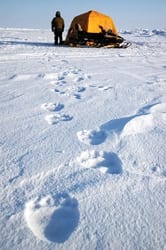Scientists Prepare for a Risky Mission Under the Arctic Ice
April 1, 2008
Bone-chilling temperatures, biting winds, and rapidly changing sea ice conditions make the Chukchi Sea off Point Barrow, Alaska, a particularly challenging place to work. And then there are the curious neighbors – towering polar bears that periodically stop by camp unannounced. These are just a few of the challenges researchers from the Woods Hole Oceanographic Institution (WHOI) faced as they performed sea ice and underwater acoustic surveys last month in preparation for a return trip in March 2009 to better understand the flow of water to the Arctic from the Pacific Ocean. “The inflow of Pacific water plays an important role in maintaining the Arctic ice cap,” said Al Plueddemann, a WHOI physical oceanographer who will lead the 2009 mission. “Interaction with the Pacific is a critical component of the Arctic system that has not been given as much attention as interactions with the Atlantic.” This region north of Alaska is where huge volumes of sea ice are formed and ocean water is transformed in ways that help shield and protect the polar ice cap. Since the process occurs beneath sea ice in winter, it is difficult to observe. To overcome that obstacle the research team plans to use an Autonomous Underwater Vehicle (AUV) to help them gather data beneath the ice. The AUV will navigate with the assistance of a few strategically placed acoustic transponders. If things go as planned, the AUV will do much of its work out of transponder range, using only internal navigation to find its way back home to an ice hole. On the recent reconnaissance trip, WHOI engineers Jeff Lord and Sean Whelan documented the performance of under-ice communications equipment and evaluated logistic support equipment, such as snowmobiles, sleds, ice-augers, tents and heaters, necessary for winter operations. They also gathered data regarding currents and salinity of the waters off the coast of Barrow, which will all be factored into the mission next winter. “This is a well-suited mission for an AUV because of the water depths, which range from 10 to 150 meters, and the relatively short distances that need to be covered,” Plueddemann said. “But it’s risky because if the vehicle malfunctions during the mission, hits an ice keel, or can’t find its way home to the ice hole it was deployed from, it may be impossible to retrieve it. Not to mention the risks to the field personnel from harsh weather and changing ice conditions.” These are risks the team is willing to take to gain a better understanding of this critical “choke point” of the Arctic circulation system and the first direct measurement of Pacific water transport into the western Arctic in winter.
Related links
- Flying Blind in the Ice Factory
Scientists test innovative technology to navigate vehicles under Arctic ice - Is Global Warming Changing the Arctic?
And will polar changes trigger climate shifts beyond the Arctic? - The Flywheel of the Arctic Climate Engine
Remote Beaufort Gyre expeditions reveal clues to climate change - A Sentry at the Atlantic Gateway
Experimental mooring monitors water flow through Hudson Strait - Under-ice Floats Offer a ‘Breakthrough’
New instrument proves its mettle in an icy ocean

